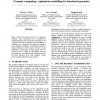2455 search results - page 38 / 491 » Computability of Models for Sequence Assembly |
DIS
2009
Springer
14 years 3 months ago
2009
Springer
Abstract. Group comparison per se is a fundamental task in many scientific endeavours but is also the basis of any classifier. Contrast sets and emerging patterns contrast betwee...
ESA
2001
Springer
14 years 1 months ago
2001
Springer
Abstract. Single nucleotide polymorphisms (SNPs) are the most frequent form of human genetic variation. They are of fundamental importance for a variety of applications including m...
STOC
2001
ACM
14 years 9 months ago
2001
ACM
Recently Rothemund and Winfree 6] have considered the program size complexity of constructing squares by selfassembly. Here, we consider the time complexity of such constructions ...
CSB
2004
IEEE
14 years 12 days ago
2004
IEEE
Proteases play a fundamental role in the control of intra- and extracellular processes by binding and cleaving specific amino acid sequences. Identifying these targets is extremel...
GECCO
2000
Springer
14 years 7 days ago
2000
Springer
Many newly discovered genes are of unknown function. DNA microarrays are a method for determining the expression levels of all genes in an organism for which a complete genome seq...

